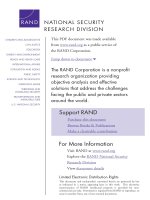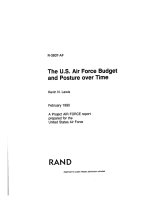Modernizing the U.S. Aircraft Carrier Fleet - Accelerating CVN 21 Production Versus Mid-Life Refueling ppt
Bạn đang xem bản rút gọn của tài liệu. Xem và tải ngay bản đầy đủ của tài liệu tại đây (409.87 KB, 126 trang )
This document and trademark(s) contained herein are protected by law
as indicated in a notice appearing later in this work. This electronic
representation of RAND intellectual property is provided for non-
commercial use only. Permission is required from RAND to reproduce, or
reuse in another form, any of our research documents.
Limited Electronic Distribution Rights
Visit RAND at www.rand.org
Explore RAND National Defense
Research Institute
View document details
For More Information
This PDF document was made available
from www.rand.org as a public service of
the RAND Corporation.
6
Jump down to document
THE ARTS
CHILD POLICY
CIVIL JUSTICE
EDUCATION
ENERGY AND ENVIRONMENT
HEALTH AND HEALTH CARE
INTERNATIONAL AFFAIRS
NATIONAL SECURITY
POPULATION AND AGING
PUBLIC SAFETY
SCIENCE AND TECHNOLOGY
SUBSTANCE ABUSE
TERRORISM AND
HOMELAND SECURITY
TRANSPORTATION AND
INFRASTRUCTURE
WORKFORCE AND WORKPLACE
The RAND Corporation is a nonprofit
research organization providing
objective analysis and effective
solutions that address the challenges
facing the public and private sectors
around the world.
Purchase this document
Browse Books & Publications
Make a charitable contribution
Support RAND
This product is part of the RAND Corporation monograph series.
RAND monographs present major research findings that address the
challenges facing the public and private sectors. All RAND mono-
graphs undergo rigorous peer review to ensure high standards for
research quality and objectivity.
Prepared for the United States Navy
Approved for public release; distribution unlimited
MODERNIZING THE U.S.
AIRCRAFT CARRIER FLEET
Accelerating CVN 21 Production
Versus Mid-Life Refueling
John Schank Giles Smith Brien Alkire Mark V. Arena
John Birkler James Chiesa Edward Keating Lara Schmidt
The RAND Corporation is a nonprofit research organization providing
objective analysis and effective solutions that address the challenges
facing the public and private sectors around the world. RAND’s
publications do not necessarily reflect the opinions of its research clients
and sponsors.
R
®
is a registered trademark.
© Copyright 2005 RAND Corporation
All rights reserved. No part of this book may be reproduced in any
form by any electronic or mechanical means (including photocopying,
recording, or information storage and retrieval) without permission in
writing from RAND.
Published 2005 by the RAND Corporation
1776 Main Street, P.O. Box 2138, Santa Monica, CA 90407-2138
1200 South Hayes Street, Arlington, VA 22202-5050
201 North Craig Street, Suite 202, Pittsburgh, PA 15213-1516
RAND URL: />To order RAND documents or to obtain additional information, contact
Distribution Services: Telephone: (310) 451-7002;
Fax: (310) 451-6915; Email:
Library of Congress Cataloging-in-Publication Data
Modernizing the U.S. aircraft carrier fleet : accelerating CVN 21 production versus
mid-life refueling / John Schank [et al.].
p. cm.
Includes bibliographical references.
“MG-289.”
ISBN 0-8330-3720-X (pbk. : alk. paper)
1. Aircraft carriers—United States—Design and construction. I. Schank, John F.
(John Frederic), 1946–
V874.3.M64 2005
359.94835—dc22
2004028962
Cover design by Barbara Angell Caslon
Cover photo courtesy of JOCS, Public Affairs, USS Ronald Reagan, United States Navy.
USS Ronald Reagan Exiting the Straits of Magellan.
The research described in this report was prepared for the United
States Navy. The research was conducted in the RAND National
Defense Research Institute, a federally funded research and development
center supported by the Office of the Secretary of Defense, the Joint
Staff, the unified commands, and the defense agencies under Contract
DASW01-01-C-0004.
iii
Preface
The U.S. Navy is currently designing the next generation aircraft car-
rier, the CVN 21. This class of carriers will use the same basic hull
form as the current Nimitz class but will include a substantial rede-
sign of the interior of the ship for improved weapons handling and
stores management functions. It will also incorporate several new
technologies, including a new propulsion plant and new aircraft
launch and recovery systems. These improvements not only will
increase the operational capability of the ship but also are anticipated
to lower the ship’s manpower requirements and maintenance costs.
Under current force modernization plans, new ships of the
CVN 21 class will be introduced every four or five years as the ships
of the Nimitz class reach the end of their planned 50-year operational
life. Under this strategy, Nimitz-class carriers will be operating for
more than 50 more years and it will take decades to transform the
aircraft carrier fleet to ships of the new class.
On the basis of some preliminary calculations that appeared
promising, the RAND Corporation proposed to the Program
Executive Office (PEO) for Aircraft Carriers an examination of a way
to accelerate the transformation of the carrier force: replacing Nimitz-
class carriers as they reach midlife instead of refueling them. In this
report, we identify specific fleet management options for building
new instead of refueling, and we evaluate their advantages and
disadvantages. This report should be of interest to Navy and Office of
Secretary of Defense planners examining fleet modernization options,
iv Modernizing the U.S. Aircraft Carrier Fleet
especially those organizations addressing the costs of alternative force
structure options.
The research documented in this report was carried out within
the Acquisition and Technology Policy Center of the RAND
National Defense Research Institute, a federally funded research and
development center sponsored by the Office of the Secretary of
Defense, the Joint Staff, the unified commands, and the defense
agencies.
For more information on RAND’s Acquisition and Technology
Policy Center, contact the Director, Philip Antón. He can be reached
by e-mail at ; by phone at 310-393-0411,
extension 7798; or by mail at the RAND Corporation, 1776 Main
Street, Santa Monica, California 90407-2138. More information
about RAND is available at www.rand.org.
v
Contents
Preface iii
Figures
vii
Tables
xi
Summary
xiii
Acknowledgments
xxiii
Abbreviations
xxv
CHAPTER ONE
Introduction 1
CHAPTER TWO
Fleet Modernization Options and Their Implications for Fleet Size
and Composition
5
Today’s Policy: The Reference Case
6
Scheduled Refueling and Maintenance
6
Fleet Composition and Size
11
A Nominal Build-New Strategy
14
Other Build-New Options with a 22-Year Unrefueled CVN 21 Life
Span
17
A Build-New Option with Unrefueled CVN 21 Life Span Extensions
23
CHAPTER THREE
Adequacy of the Industrial Base 27
NGNN
28
Production Facilities
29
vi Modernizing the U.S. Aircraft Carrier Fleet
Workforce 34
Management Functions
40
Vendors
41
Nuclear
41
Nonnuclear
42
Navy
45
Conclusion
46
CHAPTER FOUR
Life-Cycle Cost Analysis 47
Approach
47
Modeling LCC
50
Metrics for Comparison
51
Baseline Comparison
52
Comparison of All Alternatives
53
Cost Reductions from Other Sources of Savings
56
Sources
57
Cost Reductions
60
Other Considerations
62
Impact on Other Programs
62
Extended Core Life
63
Defueling and Demilitarization
64
Summary
64
CHAPTER FIVE
Synthesis 65
APPENDIX
A. CVN 21 Design and Technology Advances 75
B. Shipyard Production Labor Demand by Skill
85
C. How Life-Cycle Cost Elements Were Estimated
89
Bibliography
97
vii
Figures
S.1. A Build-New Strategy Can Modernize the Fleet Twice
as Fast
xiv
S.2. A Build-New Plan Sustains at Least as Many Operational Ships
and Almost as Many Total as the Navy’s Current Plan (Reference
Case)
xv
S.3. Increasing the Production Interval to 24 Months Costs an Extra 12
Percent
xvi
S.4. Aggressive Cost Reduction Can Cut the Nominal Build-New Cost
Premium in Half
xix
S.5. Build-New Options with a 24-Month Production Interval
Generate Greater “Fleet Value” than the Reference Plan or 30-
Month Plans
xx
S.6. Build-New Strategy Requires Managing a Labor Demand Peak
Until 2017
xxi
2.1. Operational Life Course of Nimitz-Class Carriers
9
2.2. Comparison of Nimitz-Class and CVN 21 Life Spans
10
2.3. Evolution of Fleet Composition for the Reference Case
12
2.4. Fleet Modernization Profile for the Reference Case
13
2.5. Fleet Size for the Reference Case, 2010–2050
13
2.6. Assumed Life Cycle of Nimitz- and CVN 21–Class Carriers for
the Build-New Strategy
14
2.7. Evolution of Fleet Composition for the Nominal Build-New
Case
15
2.8. Fleet Size Sustained by Nominal Build-New Strategy,
2010–2050
16
viii Modernizing the U.S. Aircraft Carrier Fleet
2.9. Fleet Modernization Rate, Reference Case Versus Build-New
Strategy
17
2.10. Fleet Size Sustained by Build-New Strategy with Extended New
Start Interval (30/72)
19
2.11. Fleet Modernization Rate, Reference Case Versus 24/72 and
30/72 Options
20
2.12. Fleet Size Sustained by Build-New Strategy with No RCOH
After CVN 71 (24/71)
21
2.13. Fleet Size Sustained by Build-New Strategy with Combined Cost-
Saving Variants (30/71)
22
2.14. Two Hypothesized Extended Unrefueled Life Cycles for CVN 21–
Class Ships
23
2.15. Fleet Size Sustained by 30-Month Build-New Interval and 26-
Year Unrefueled Life Span
24
2.16. Ship Life Sustained by 30-Month Build-New Interval and 30-
Year Unrefueled Life Span
25
3.1. Workload Profile for CVN 21 Construction and RCOH
35
3.2. Total Shipyard Labor Demand for Reference Case and Nominal
Build-New Option
36
3.3. Total Shipyard Workforce Demand for Alternative Carrier
Modernization Plans
37
3.4. Total Shipyard Outfitting-Labor Demand for Reference Case and
Nominal Build-New Option
38
3.5. Total Shipyard Welder Demand After 2016 for Alternative
Shipyard Modernization Plans
40
4.1. Influence Diagram for LCC Elements
50
4.2. Cost Comparison, Reference Case Versus Nominal Build-New
Option
53
4.3. Cost Comparison per Operational Ship-Year, Reference Case
Versus Nominal Build-New Option
54
4.4. Annual Funding Premiums of All Build-New Options Relative
to the Reference Case
56
4.5. Reduction in Engineering Hours with Two-Ship Buys
58
4.6. Workforce Learning on the Nimitz Class
59
4.7. Effects of Other Sources of Savings on LCC, Nominal Build-New
Option
60
Figures ix
4.8. Effect of Other Sources of Savings on LCC in All Build-New
Options
61
4.9. Effect of Other Sources of Savings on LCC per Operational Ship-
Year in All Build-New Options
62
4.10. Effect of Other Sources of Savings on Annual Funding Premiums
in All Build-New Options
63
5.1. Fleet Value of 24/72 Plan as Percentage Increment over Reference
Plan for Different CVN 21 Capability Increments
69
5.2. Fleet Value as Percentage Increment over Reference Plan for
Different Build-New Options
70
5.3. Fleet Value as Percentage Increment over Reference Plan for
Different Build-New Options and Capability Ratios
71
5.4. Fleet Value as Percentage Increment over Reference Plan, for
Different Build-New Options, No Discounting
72
C.1. Influence Diagram for LCC Elements
89
C.2. Budget Profiles for Carrier Acquisition, Relative to Year of Full
Funding
94
xi
Tables
S.1. Build-New Options with Best Cost Implications Have Worst Fleet
Size Implications
xvii
2.1. Life Spans of Current Aircraft Carriers
6
2.2. Characteristics of Fleet Management Options Analyzed
18
2.3. Average Fleet Size for Build-New Options, 2010–2040
22
3.1. Times to Construction Milestones for Nimitz-Class Carriers
29
3.2. NGNN Facility Costs for Options Analyzed
33
4.1. Cost Comparison of Build-New Options with Reference
Case
54
5.1. Fleet Size and Cost Effects of All Build-New Options
66
B.1. Maximum Rate of Change in Labor Demand
86
B.2. Mean Labor Demand from 2005 to 2025
86
B.3. Standard Deviation of Labor Demand from 2005 to 2025
87
xiii
Summary
The U.S. Navy is currently building the last of the Nimitz class of
aircraft carriers. The next ship to be started will belong to a new class,
designated CVN 21. This new design will incorporate numerous
improvements over the Nimitz design. Among the most important
will be improved weapons handling, a propulsion plant that will gen-
erate more electricity to support functions now controlled by steam
and hydraulics, an electromagnetic aircraft launch system, and a gen-
eral rearrangement to improve operations. It is anticipated that the
new class of ship will require fewer personnel to operate and will
spend less time in shipyard maintenance, both of which will contrib-
ute to reduced operating costs.
The Navy’s plan is to continue building aircraft carriers
approximately once every four years. Ships of the new class will
replace older ones that are retiring. Nimitz-class ships are scheduled
to retire at approximately age 49, after two 23-year operational peri-
ods separated by a three-year midlife refueling and complex overhaul.
This plan will transform the carrier fleet into one composed of
the higher-performance, lower-cost CVN 21 ships at a very slow rate.
Even in 2035, half the fleet will be Nimitz-class ships.
We here propose a more rapid modernization plan: building
new aircraft carriers more often and retiring about half the Nimitz-
class ships at what would have been their midlife refueling point. We
compare several variations of this approach with a reference case
approximating the Navy’s current plan. Criteria for comparison
include rate of fleet modernization, average number of ships sustained
xiv Modernizing the U.S. Aircraft Carrier Fleet
(total and operational), present value of acquisition and operating
costs, and near- and midterm funding required. Our central finding is
that the fleet can be modernized much faster, even twice as fast, for a
cost premium no greater than 12 percent. That premium can be
reduced through decreasing fleet size by 5 to 10 percent or possibly
through aggressive cost reduction efforts. We also find that the indus-
trial base is adequate to support the higher production rate.
The gain from a shorter interval between carrier production
starts is depicted in Figure S.1, which shows the percentage of the
total carrier fleet made up by the CVN 21 class as of the dates
shown.
1
If the time between new carrier construction starts is
halved—that is, if the production interval is dropped from the cur-
Figure S.1
A Build-New Strategy Can Modernize the Fleet Twice as Fast
RAND MG289-S.1
Percentage of fleet in CVN 21
Year
100
24-month
production interval
Reference case
80
60
40
20
0
2010 2020 2030 2040 2050 2060
____________
1
Note that we show the CVN 21 percentage reaching and staying at 100 percent. However,
we assume in all our analyses that CVN 21–class carriers are also retired when their initial
fuel load is exhausted and that they too are replaced by carriers (presumably a follow-on
class) built new.
Summary xv
rent notional 48 months to 24 months, the fleet is modernized twice
as fast. CVN 21s will make up the fleet majority 12 years earlier, and
the fleet will be transformed 22 years earlier.
As shown in Figure S.2, a 24-month interval sustains a fleet that
is about half a ship short of the reference fleet in size. However, the
number of operational ships (those not in the shipyard) is at least as
great as in the reference case. This bonus emanates from the lower
maintenance requirements designed into the CVN 21. More CVN
21s in the fleet mean more ships available for deployment or training.
These benefits come at a cost. Although the larger number of
CVN 21s in the fleet translates into lower personnel and maintenance
costs, the fleetwide savings are not large, particularly for personnel,
for two reasons. First, it still takes a number of years for the fleet to
evolve from a Nimitz-class fleet to a CVN 21 fleet; second, the
greater savings many years in the future are worth much less than
Figure S.2
A Build-New Plan Sustains at Least as Many Operational Ships and Almost
as Many Total as the Navy’s Current Plan (Reference Case)
NOTE: Reference case data displayed as dotted lines.
RAND MG289-S.2
Number of carriers
Year
14
Total in fleet
Operational
12
10
8
4
2
6
0
2010 2015 2020 20302025 2040 20452035 2050
xvi Modernizing the U.S. Aircraft Carrier Fleet
their nominal value today—that is, they must be discounted. Further-
more, a multibillion-dollar charge is incurred when an extra carrier is
built every fourth year. Less than half those charges are offset by
avoiding refueling a Nimitz-class ship. If the various costs and savings
offsets in the construction, personnel, and operations and mainte-
nance budgets are calculated for the 50-year period beginning in
2002, the net result is a cost premium for the build-new plan. That
premium amounts to 12 percent, or $22 billion in present discounted
value (see Figure S.3).
2
The extra costs would manifest themselves as
an added $700 million annual budgetary requirement from 2005 to
2015 alone.
We examined two approaches to reducing that cost premium.
First, we varied the specifics of the build-new strategy. Instead of 24
months, we tried a 30-month interval, which would modernize the
Figure S.3
Increasing the Production Interval to 24 Months Costs an Extra 12 Percent
RAND MG289-S.3
Discounted life-cycle cost, 2002–2052
(FY 2002 $ billions)
250
200
150
100
50
0
Reference case 24-month interval
Other costs
Maintenance
Personnel
Acquisition
____________
2
For lack of data, our estimates do not include the cost of defueling and demilitarizing
retired carriers, activities that will occur earlier and more frequently under the build-new
plan than in the reference case. Our cost premium estimate may thus be somewhat con-
servative.
Summary xvii
fleet almost as fast as the 24-month option. We tried retaining the
24-month interval but running one fewer Nimitz refueling (stopping
with CVN 71 instead of CVN 72). Finally, we analyzed an option
combining these two variants.
The results are shown in Table S.1. The first row under “After
CVN 72” represents the nominal build-new plan and the other three
cells (where each cell comprises w/x y% (z%)) represent the three
alternatives just specified (further explanation follows).
The 30-month variants solve the cost problem. The cost premi-
ums relative to the reference plan are near zero or even negative (see
the numbers outside parentheses on the right side of each cell in
Table S.1). However, the variants have the effect of taking one or
more ships out of the fleet (see the numbers at the left under both the
“After CVN 72” column and the “After CVN 71” column; the total
reference fleet averages 12.1 ships). The penalty in operational ships
ranges from almost nothing for the 24-month plan with one less refu-
eling and complex overhaul (RCOH) to half a ship or more for the
30-month plans (see the numbers on the left side of each cell, to the
right of the slash; the reference fleet averages 8.4 operational ships).
Our second approach to reducing the cost premium was to
examine several cost reduction measures:
• Multiship buys: The faster build schedule might promote two-
ship contract packages that could lower costs for engineering
and for materials and equipment.
Table S.1
Build-New Options with Best Cost Implications Have Worst Fleet Size
Implications
When to Stop Performing RCOHs
How Long to Allow
Between CVN 21 Starts After CVN 72 After CVN 71
24 months 11.7/8.7
a
+12% (+6%)
b
10.9/8.2
a
+8% (+1%)
b
30 months 10.6/7.9
a
+1% (–4%)
b
9.8/7.3
a
–3% (–8%)
b
a
Numbers represent total fleet/operational fleet.
b
Numbers represent nominal cost premium (additional saving).
xviii Modernizing the U.S. Aircraft Carrier Fleet
• Learning: A faster build schedule could allow for lower costs on
repeated production tasks. We assumed for the build-new strat-
egy a slight advantage over the lack of learning we assumed
(from historical precedent) in the reference case.
• Additional crew reduction: The Navy postulates a crew reduc-
tion of as many as 800 for the CVN 21 versus the Nimitz class.
We adopted 800 as the reference case reduction and postulated
that an additional 200 crew members could be removed with
aggressive measures to reduce ship manning.
• Outsourcing: We assumed a small increase in outsourcing over
what is expected, for a modest labor cost savings on the work
outsourced.
The cumulative effect of these savings on the original, nominal
build-new plan are shown in Figure S.4. The relative effects of the
measures are in the order listed above, with multiship buys having the
greatest effect and outsourcing the least. Together, these cut the
build-new plan’s 12-percent cost premium by 7 percentage points, or
more than half. Applying these measures to the variant build-new
options also cuts their costs by 5 to 7 percent, as indicated by the par-
enthetical numbers in Table S.1. We regard these cost reduction
measures as ambitious but feasible. By adopting them and by elimi-
nating the CVN 72 RCOH (see top right cell in Table S.1), the Navy
could modernize faster at hardly any cost premium.
The trade-off between faster modernization and a smaller opera-
tional fleet can be quantified in terms of future operational CVN 21
ship-years. Those ship-years can then be multiplied by a factor indi-
cating the ratio between a CVN 21–class ship’s capability and a
Nimitz-class ship’s capability, and future operational Nimitz-class
ship-years can be added in. The result, which needs to be discounted
for comparison with discounted costs, is the present value of future
operational ship-years, weighted to favor CVN 21–class ships: a
measure of the fleet’s value to the Navy. The value is higher if the
fleet converts more quickly to CVN 21s or if the number of opera-
tional ships is typically larger.
Summary xix
Figure S.4
Aggressive Cost Reduction Can Cut the Nominal Build-New Cost Premium
in Half
RAND MG289-S.4
NPV premium ($ billions over
reference plan)
25
20
15
10
5
0
Nominal
build-new
with
outsourcing
and crew
reductions
and
learning
and
multiship
It was not within the scope of this report to predict a most likely
CVN-21:Nimitz capability ratio. However, we examined several pos-
sibilities to get a sense of the fleet value premiums achievable. If, for
example, the Navy were to view a CVN 21–class ship as 30 percent
more capable than a Nimitz-class ship, the nominal build-new plan
would result in a 7 percent fleet value premium over the reference
case (see Figure S.5). That is, the fleet would have an average opera-
tional capability 7 percent higher (in discounted terms) than it would
if the reference plan were followed. That may be compared with the
12 percent (or 6 percent) cost premium from Table S.1. Eliminating
the CVN 72 RCOH, as noted above, virtually eliminates the cost
premium if aggressive cost reduction is pursued. Figure S.5 indicates
a fleet value premium of 4 percent. Whether these are good invest-
ments or not depends on the importance the Navy attaches to fleet
value premiums of those sizes.
xx Modernizing the U.S. Aircraft Carrier Fleet
Figure S.5
Build-New Options with a 24-Month Production Interval Generate Greater
“Fleet Value” than the Reference Plan or 30-Month Plans
NOTE: CVN 21 capability increment = 30%
RAND MG289-S.5
Fleet value premium over that of
reference plan (percentage)
8
6
4
0
–2
2
–4
–6
24/72 24/71 30/72
Build-new plan designator (interval/last RCOH)
30/71
No industrial-base impediments hamper implementation of any
of the build-new options defined here. A significant short-term tran-
sient in the shipyard labor profile occurs (see Figure S.6, 2017 and
before), peaking at 24 percent over the reference plan. This demand
must be managed, but the build-new strategy affords an opportunity
for greater long-term workforce stability (after 2017). This is true as
well for the variant build-new options, although for those both the
peaks and the long-run average demands are somewhat lower than in
the nominal build-new option.
Some facility upgrades are needed at the shipyard, but there
appear to be no critical problems there. Suppliers of parts for the
nuclear-propulsion plant will need to undertake some modest
upgrades. The challenge there, however, is not really capacity but
timing. If a build-new strategy is to be implemented so that the sec-
ond CVN 21–class ship is started in 2009, propulsion plant supplier
upgrades must begin promptly (i.e., long lead item procurement must
Summary xxi
begin in FY 2005 to support an FY 2009 ship). Vendors of non-
nuclear components are generally in place and capable of meeting the
higher production rate.
Figure S.6
Build-New Strategy Requires Managing a Labor Demand Peak Until 2017
RAND MG289-S.6
Year
2005
Total shipyard labor demand
2010 2015 20252020 20352030 2040
Reference case
Nominal build-new
xxiii
Acknowledgments
Our work on this project was greatly facilitated by personnel at the
Program Executive Office for Aircraft Carriers, in particular Brian
Persons, deputy program executive officer. We also appreciate the
efforts made by CAPT Dudley Berthold, former CVN 21 program
manager; CAPT Mike Schwartz, current CVN 21 program manager;
and CDR Chris Meyer, assistant program manager. At the Naval
Nuclear Propulsion Program (NAVSEA 08), Robert Murphy and
Karen Henneberger contributed to our endeavors. Kenneth Dieter at
NUWC provided the data for Appendix C on the cost of carrier
maintenance availabilities and answered our queries regarding its
interpretation.
We are grateful to Dan Burton, who acted as our facilitator and
interface at Northrop Grumman Newport News. We also received
valuable assistance there from Matthew Mulherin, vice president for
the CVN 21 program.
Max Buzard at Royer Technical Services played a key role in
that firm’s execution of a subcontract for RAND related to the
amount of outsourcing possible on future carriers. Anne Wolpert of
Tecnico Corporation contributed to providing cost estimates for
subcontractor efforts.
We owe part of the inspiration for this project to some early cal-
culations by our RAND colleague John Halliday. We are also
indebted to our formal reviewers, David Stem of RAND and J. Tal-
bot Manvel, former director of the CVN 21 program at the Naval









